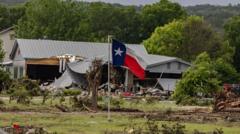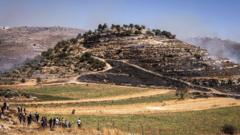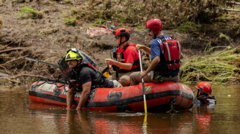As Texas grapples with the aftermath of deadly flash floods that claimed at least 120 lives, including 96 in Kerr County, officials are facing intense scrutiny over the delayed emergency alerts. Investigations reveal that crucial warnings to residents were issued nearly six hours late, amid ongoing rescue efforts for over 160 individuals still unaccounted for.
Texas Flood Crisis: Emergency Alert System Under Scrutiny as Death Toll Rises

Texas Flood Crisis: Emergency Alert System Under Scrutiny as Death Toll Rises
Questions mount regarding emergency responses during catastrophic floods in Kerrville, Texas, where over 120 lives have been lost.
The article text:
Texas officials are under increasing pressure to explain the delayed emergency alerts issued during devastating flash floods that left at least 120 dead, including 96 in Kerr County alone, with 36 of those being children from a nearby Christian camp. During a Thursday press conference, community services officer Jonathan Lamb from Kerrville Police responded to inquiries about a possible failure in the police radio communications by stating he lacked information on the issue.
Over the past week, residents have been demanding answers regarding the emergency communication breakdown that unfolded following severe flooding after an extraordinary rainfall event that dumped approximately 100 billion gallons over the region. Alarmingly, an audio recording from a firefighter located upstream indicated that urgent calls to notify residents were made at 4:22 a.m. on July 4, yet residents did not receive any alerts until almost six hours later.
ABC News reports that the initial alert via Kerr County's CodeRED system came roughly 90 minutes after the firefighter's plea, highlighting a significant lag in responding to the growing danger. The dispatcher could be heard in the recording responding with, "Stand by, we have to get that approved with our supervisor."
Local officials were pressed about these delays at a subsequent press conference, and Kerr County Sheriff Larry Leitha admitted he was notified of the situation around four to five hours after the floods began, suggesting that clarifying a timeline of events would take time. "That is not my priority this time," he stated, emphasizing that his focus remained on locating the missing and identifying victims of the floods.
As the situation stands, over 160 individuals remain missing, including five campers and a counselor from Camp Mystic. Since the onset of the flooding, rescue operations have not yielded any additional survivors, raising concerns about the effectiveness of local emergency protocols.
While weather forecasters issued multiple alerts warning of heavy rains leading up to the disaster, officials cited a combination of factors—such as a lack of cell phone service, failure to gauge the storm’s severity, and community desensitization to alerts in a region historically vulnerable to flooding—as contributing factors to the slow evacuation response.
In an effort to address the crisis, President Donald Trump signed a federal disaster declaration, allowing the Federal Emergency Management Agency (FEMA) to mobilize resources and provide assistance to affected communities. Over 2,100 personnel—including responders on the ground, helicopters, drones, boats, and cadaver-detecting dogs—are actively engaged in recovery operations to find the missing or identify victims amidst the debris.
Lt. Colonel Ben Baker of the Texas Parks & Wildlife Department illustrated the challenges faced by rescue teams, stating, "These large piles (of debris) can be very obstructive... We're having to go layer by layer, peeling these off, to make those recoveries."
The investigation into the delayed emergency alerts continues, as Texas officials work to confront this tragedy and improve future emergency response capabilities.
Texas officials are under increasing pressure to explain the delayed emergency alerts issued during devastating flash floods that left at least 120 dead, including 96 in Kerr County alone, with 36 of those being children from a nearby Christian camp. During a Thursday press conference, community services officer Jonathan Lamb from Kerrville Police responded to inquiries about a possible failure in the police radio communications by stating he lacked information on the issue.
Over the past week, residents have been demanding answers regarding the emergency communication breakdown that unfolded following severe flooding after an extraordinary rainfall event that dumped approximately 100 billion gallons over the region. Alarmingly, an audio recording from a firefighter located upstream indicated that urgent calls to notify residents were made at 4:22 a.m. on July 4, yet residents did not receive any alerts until almost six hours later.
ABC News reports that the initial alert via Kerr County's CodeRED system came roughly 90 minutes after the firefighter's plea, highlighting a significant lag in responding to the growing danger. The dispatcher could be heard in the recording responding with, "Stand by, we have to get that approved with our supervisor."
Local officials were pressed about these delays at a subsequent press conference, and Kerr County Sheriff Larry Leitha admitted he was notified of the situation around four to five hours after the floods began, suggesting that clarifying a timeline of events would take time. "That is not my priority this time," he stated, emphasizing that his focus remained on locating the missing and identifying victims of the floods.
As the situation stands, over 160 individuals remain missing, including five campers and a counselor from Camp Mystic. Since the onset of the flooding, rescue operations have not yielded any additional survivors, raising concerns about the effectiveness of local emergency protocols.
While weather forecasters issued multiple alerts warning of heavy rains leading up to the disaster, officials cited a combination of factors—such as a lack of cell phone service, failure to gauge the storm’s severity, and community desensitization to alerts in a region historically vulnerable to flooding—as contributing factors to the slow evacuation response.
In an effort to address the crisis, President Donald Trump signed a federal disaster declaration, allowing the Federal Emergency Management Agency (FEMA) to mobilize resources and provide assistance to affected communities. Over 2,100 personnel—including responders on the ground, helicopters, drones, boats, and cadaver-detecting dogs—are actively engaged in recovery operations to find the missing or identify victims amidst the debris.
Lt. Colonel Ben Baker of the Texas Parks & Wildlife Department illustrated the challenges faced by rescue teams, stating, "These large piles (of debris) can be very obstructive... We're having to go layer by layer, peeling these off, to make those recoveries."
The investigation into the delayed emergency alerts continues, as Texas officials work to confront this tragedy and improve future emergency response capabilities.




















